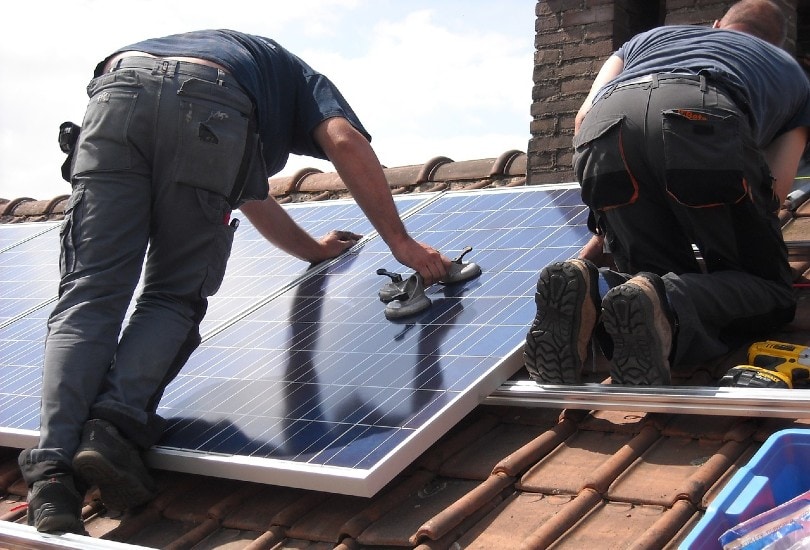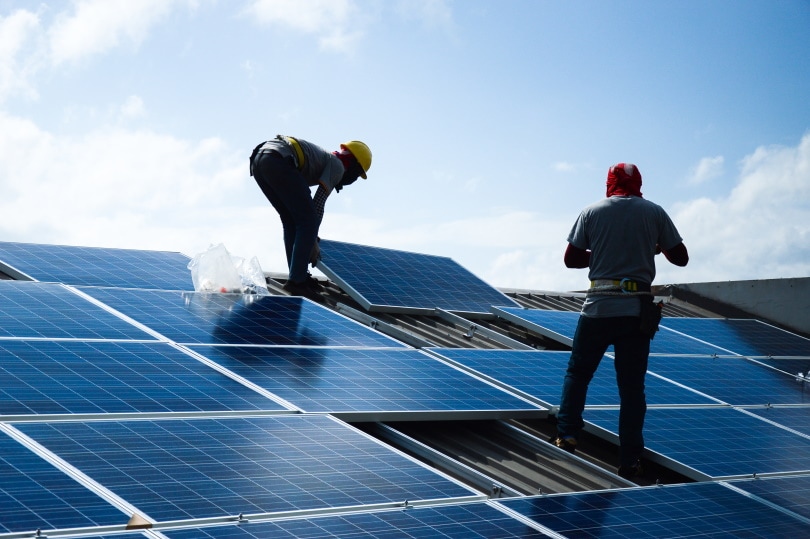How Do Solar Panels Work? What You Need To Know!
-

- Last updated:

The concept is simple. Sunlight provides a reliable and free source of heat energy. It’s renewable with no concerns about emissions—at least at the source. While it only accounted for 2.3% of the 2020 electricity output, it’s poised to take a more prominent role in meeting our energy needs.1 You may wonder, how does solar energy work?

History of Solar Panels

Solar-thermal powerplants and standalone installations using photovoltaic (PV) panels are two leading technologies. Both work similarly, with the differences resting with the operation’s scale. The other thing to understand is that the theory isn’t new. Scientists, such as Augustin Mouchot, experimented with its development in the mid-1800s.
Albert Einstein picked up the reins and expanded these early concepts to describe the photoelectric effect. It would earn him the 1921 Nobel Prize in physics. A pivotal moment occurred in 1954 with Bell Laboratories’ development of the first silicon solar cell. This creation is significant, given the early obstacles in the industry. Efficiency was one of the primary stumbling blocks.
The industry continued to labor while technological advances chipped away at the problems. Feasibility, efficiency, and storage continued to plague the advancement. Bell and other manufacturers continued their R&D in solar cells. The 1980s saw an upturn in the development that would make solar power a reality. But the question remains, how does it work?
Solar Power 101

Sunlight provides the fuel. We know it gives off heat and light. The next step is converting those energy sources into electricity. Semiconductor materials in solar cells provide negatively and positively charged sides. When sunlight hits them, it excites the electrons that, in turn, create the direct current (DC) electricity. You may wonder how DC can power AC appliances and devices.
That’s where a solar inverter comes into the picture. There are two types. Microinverters work directly with the panel to convert the juice to AC. String inverters are like command centers, which concentrate all the action in one place, typically on the side of a building. Once the electricity is converted, it’s simply a matter of connecting it to your house’s system.
Two ways to handle any extra power generation exist. You can have your system set up to stream it to the grid and keep track of the in-out flow with an electric meter. Another option is to store it using an Energy Storage System (ESS). This aspect of the technology has been a stumbling block. It’s also an industry that is in its infancy.
Anatomy of a Solar Panel

Examining the anatomy and mechanics of a solar panel can enrich your understanding of how it works. Each one consists of a specific number of solar cells, varying from one to several inches wide, depending on its use. The electricity from a single cell isn’t much. It’s the sum of the parts that determine the output. The setup is called an array.
Types of Solar Cells
Several kinds of solar cells exist, each offering pros and cons. Some are also better suited to certain applications. Silicon was the first material scientists used to create solar cells. It is affordable with excellent efficiency. That’s why you’ll still see it in products today. The types you’re most likely to see are monocrystalline, polycrystalline, or thin-film solar panels.
Monocrystalline Solar Panels
Monocrystalline solar panels kick up the efficiency game a notch with high-purity silicon at one crystal per cell. You can tell if a building has this technology by the color of the black panels. While they are more expensive, any installation will also have a smaller footprint. They also offer homeowners cost savings with a 25–35 year lifespan.
Polycrystalline Solar Panels
As the name implies, polycrystalline solar panels consist of cells with multiple silicon crystal fragments. That lowers the manufacturing cost, making them more affordable. However, it comes at the price of less efficiency and longevity. The panels are blue, which may put them in the deal-breaker category since they’ll stand out more.
Thin-Film Solar Panels
Thin-film solar panels more accurately describe a second-generation technology in this industry. They are often more affordable because of their construction with multiple layers of materials. Cadmium telluride (CdTe) panels are highly efficient and do a better job of converting energy into electricity. However, they contain toxic materials that have negative environmental impacts at the source.
The advantage of amorphous solar panels is that they don’t contain the hazardous materials that the last type has. As the name implies, they are bendable, making them an excellent choice for various applications that require this feature. However, both technologies still struggle with the efficiency equation even if they are affordable.
Other products in this category include organic photovoltaic cells and copper gallium indium diselenide (CIGS) solar panels. Energy efficiency, cost, and lifespan are among the disadvantages of these options. The other concern is recyclability. The materials of thin-film solar panels require special handling, which adds to their overall cost.
- Related Read: What Are Solar Panels Made Of? What You need To Know!

The Rise of Solar Power

One overriding factor that has influenced solar power adoption has been the cost. The good news is that it’s a fraction of what it was just 12 years ago. We have to chuckle at the irony of something going down in price in these days of skyrocketing inflation.
The industry uses the cost per watt as a means to gauge the price and give potential buyers an installation estimate. In 2010, it was $5.79. While technological advances have made solar power more feasible, cost remained an issue. In 2020, it dropped to $1.25. This factor plays a direct role in how solar panels work. For example, thin-film panels often use materials outside of the typical ones in solar cells.
Factors Affecting How Solar Panels Work

We have to address the elephant in the room and discuss what makes a solar panel tick, sunlight. The National Renewable Energy Laboratory (NREL) focuses much energy on R&D for solar and other renewable sources. One of its most valuable contributions has been its maps showing the direct normal irradiance (DNI) of the United States.
One of the struggles with solar power is the uneven distribution of sunlight across the globe. It’s evident when you look at these maps that the southwestern quadrant of the country has the best potential. The New England Coast and the Pacific Northwest have the least. That can become a driving factor in the direction of solar power R&D to overcome the challenges that these areas face.
That’s particularly true since the percentage of electricity by hydropower has steadily been declining since the 1950s. That can set the stage for a more significant role for solar power and changes in how it works to overcome these site-specific issues.

Final Thoughts
Solar power offers tremendous potential as the world comes to grips with the effects of climate change. The advances in just the last decade show that this technology is actively evolving. We offer a snapshot in time of how solar panels work. Ten years from now, it may take a different path. We’ve figured out how to harness the sun’s energy. Next, we need how to use it more efficiently.
See Also:
- Can You Put Solar Panels On a Metal Roof? What You Need To Know!
- Are Solar Panels Good for the Environment?
- Renewable Energy in India Statistics
- Solar Shingles vs Solar Panels: How Do They Compare?
Featured Image Credit: Kindel Media, Pexels
Contents
